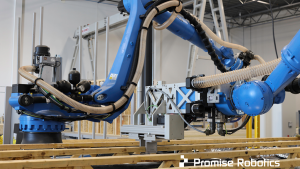Architecture schools in Alberta and Manitoba are preparing architects to visualize and create a new era of adaptive building design that will respond to climate change.
John Brown, dean of the University of Calgary’s School of Architecture, Planning and Landscape, and Mira (Mimi) Locher, dean of the University of Manitoba’s School of Architecture, both say climate change is prompting a rethinking of buildings, which are a major source of greenhouse gases, and that design and construction should include a longer life, breaking the cycle of knock-down and build new.
“We need to be building with more durable materials and with the idea that buildings can be flexible in their function,” said Locher, adding the role of a library, for example, may change with increased digital media. “We need to be able to design with the idea of flexibility and for buildings to last a long time. They need to be modular and have components that can go in and out, yet, still allow for individual personality.”
Brown said the concept of demolishing a structure that only has a lifespan of 20 to 30 years is wasting the energy and resources that went into that structure, while more energy is then expended to construct a replacement structure. There is the need to move toward buildings that will endure and are adaptable.
“It is an important idea; it is about adaptive reuse,” he said, adding a long view of buildings would see 100 years as a minimum, which also would sequester carbon for longer periods.
AI and technology to play pivotal role
Brown said his school is challenging climate change on three fronts: preparing students for what is to come and learning to provide adaptive structures; providing a doctoral program for architects that are looking to leverage their expertise and explore new solutions; and finally through student-faculty research in areas such as computer design, robotics and heavy timbers.
“It is multi-pronged,” he said.
Brown said the research in computer design is using artificial intelligence, algorithms and multiple-source data to determine optimum building design.
“You can take wind speed and where are the prevailing winds,” he said, to determine a building design that best minimizes the impact of winds, but then also use other data such as daylight and energy loss to gain the optimum shape.
“The design is shaped by the data. You can determine where you get the maximum performance,” he said, adding the design can also consider data such as projected global impacts.
“There are real advantages of using computer design and artificial intelligence, data and all the algorithms in building design. They are also creating a new role for the designers,” he said.
Architects, Brown said, should have a sense of entrepreneurship in bringing forward new design ideas to integrate into communities and meet socio-economic needs.
In an interview with Archinect website, Brown said. “Climate change and social equity is incumbent on us as a discipline, and we’re not going to lead that by putting in RFPs and enabling someone else’s dreams. We shouldn’t be waiting around for a client to approach us. The discipline is more engaged with solving impactful problems in the world.”
Students not prepared to sit around and wait for change
Locher sees architects undergoing what she calls a “big shift” in how they view the designs they provide in the future. Architecture has focused on humans, she said, but climate change is demanding a larger view.
“All living things are relative. You want to start with that view and be thinking of whether what you do is disruptive to those relatives and how to improve the conditions that are relative. That effect will be multi-generations. That viewpoint is different from what most of us were taught,” she said.
She points to something as small as pollinators, which are integral to many of food sources and how climate change can disrupt food supply.
“We need them and depend upon them. When we design, how can we support them?” she said. “What role do we play in providing an environment to achieve food production?
“And, how do we support our water systems and how do we understand flooding?” she said, pointing to innovations such as designing blue roofs that can trap water for building uses, cooling or slow release into municipal systems.
New technologies will play a key role in mitigating climate change impact, she said.
“But, we can’t solve everything. We have to understand how the natural systems work and how to assess them so our designs will work with them and ensure that our designs are improving and not exacerbating conditions,” she said.
The changes are all proving an exciting new environment for high school students opting into the study architecture, said Brown.
“What we are offering is the ability to think big and outside the box and what options are there for a new kind of future,” he said. “High school students are not prepared to sit around and wait for change.”











Recent Comments